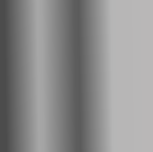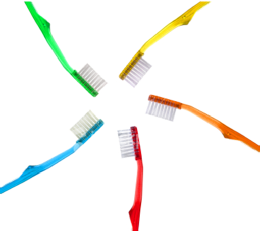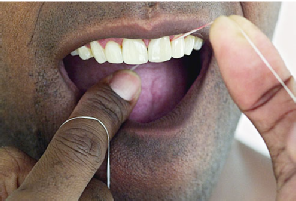


Patient Information: Preventing Tooth decay
Why does healthy eating matter?
Your general health and your resistance to many diseases depend a lot on eating a healthy, balanced diet.
Your eating and drinking habits influence the health of your teeth.
Dental plaque is a soft, sticky substance that builds up on your teeth. It is mostly made up of bacteria, which feed on white sugar found in food and drink, producing acids. The acids attack the teeth by dissolving the minerals in the tooth surface. It causes the enamel to change colour. Tooth decay develops in the tooth and you get a hole in your tooth.
Acids in food and drink can dissolve away tooth surface. All fizzy drinks (including 'diet' brands and fizzy mineral water), all squashes and all fruit juices are acidic to varying degrees. Pure fruit juice is most acidic followed by fizzy drinks then squashes. Too much of acidic drinks caused excessive wear. Everything in moderation. Enjoy fizzy drinks at meal times and avoid sipping them through the day.
Chewing sugar free gum can help, as this increases the flow of saliva, which helps teeth reduce the acidity in the mouth.
Between meals you should on avoid fizzy sugary drinks. Milk and water are recommended drinks as are tea and coffee.
Try to avoid snacking between meals. If you do snack, only have 'safe' snacks, which are low in sugar. Fruits, vegetables and products such as sandwiches, toast, crumpets and pitta bread are all 'safe' snacks. Avoid chocolate, energy drinks and biscuits as an alternative to a meal.
Anything which contains the white sugar that you put in tea and on cereals, causes a build up of plaque. This type of sugar is found in most confectionary especially chocolate, Lucozade and coke . The bacteria in your mouth thrive with this type of sugar and produce plaque which dissolve your teeth and damages your gums. Basically everything in moderation. Reduce the frequency of sugary intakes in-
For your general health, you should be eating at least five portions of vegetables and fruit every day. Dairy products, such as cheese, are 'safe' snacks for teeth; but, for the sake of your general health, choose lower fat varieties and don't have too much. Foods high in anti-
Through evolution we have become programmed to be crave high energy foods like sugary snacks. They stimulate a part of the brain which encourages us to eat more. Basically once we start eating a sweet food like chocolate, one cube is never enough. So don’t put in the fridge or your car or handbag as the temptation will become to great.
In Summary:
• Always brush your teeth twice a day with fluoride toothpaste, once on the morning and last thing at night.
• Only have 'safe' drinks and 'safe' snacks between meals.
• Eat at least five portions of vegetables and fruit every day.
• Chew sugar free gum after eating when it's not possible to brush
TOOTH BRUSHING AND FLOSSING
Brushing your teeth twice a day with fluoride toothpaste helps prevent tooth decay and gum disease.
Remember your toothbrush is more important than your toothpaste. It's the physical removal of the plaque from around the teeth which is the most important thing. So brush slowly, gently and thoroughly, visiting each surface of the tooth and aim for the tips of the tooth-
Even if your gums bleed after brushing or flossing keep going. It will generally improve day by day and disappear after 6 weeks. If you are unsure visit a dentist for reassurance.
The bristles of a toothbrush never pass between the teeth and this is where floss, interdental brushes, TePe’s, flossettes and the many other tools available that come onto play to help us disturb the plaque between the teeth.
 • Brush your teeth thoroughly twice a day with a medium sized head medium bristle strength tooth-
• Brush your teeth thoroughly twice a day with a medium sized head medium bristle strength tooth-
• Point the bristles at the join between teeth and gums, and brush using short circular movements.
• Brush all round every tooth, carefully making sure you can feel the brush on your gums.
• Don't use too much force -
• After brushing, you should spit out the toothpaste -
• Replace the brush when the bristles flare.
FLOSSING
The bristles of a toothbrush never reach in- You may want to ask your dentist or hygienist for a flossing demonstration but generally it is advised that you:
You may want to ask your dentist or hygienist for a flossing demonstration but generally it is advised that you:
• Take a length of floss about 45cm (18 inches) long;
• Wrap the ends around the middle fingers of each hand, leaving 5-
• Using the forefingers and thumbs to grasp the floss near the middle, slide the floss into the space between two teeth. Be careful not to force or snap the floss between the contact areas, as this may injure the gum line. If the contact area is very tight gently slide the floss horizontally forward and back until it squeezes through;
• Curve the floss, in a 'C' shape, around the tooth with fingers as close to the tooth as possible;
• Move the floss up and down the side of the tooth several times, gently stroking the plaque away from the gums and off the teeth;
• Then pull the floss out of the space between the teeth;
• Wind more floss onto one middle finger and off the other to reveal a fresh piece as it becomes soiled;
• Repeat with the side of the next tooth and continue around the mouth.
You may wish to rinse after flossing to remove any debris.
VISIT THE DENTIST
 A dental examination shows how healthy your mouth is. After the examination, you and your dentist can discuss the results and plan the best way to deal with any problems.
A dental examination shows how healthy your mouth is. After the examination, you and your dentist can discuss the results and plan the best way to deal with any problems.
“Prevention is better than the cure. Missing just one brushing episode increased your risk of tooth decay. It is my opinion that it would take approximately 6 weeks of regular brushing to get back to the level of hygiene before you missed a tooth brushing episode. So be fastidious and religious with your brushing routine. Toothpastes, flossing and mouth wash have a role in keeping mouth bacteria controlled, but it is your tooth brush that is key to cleaning your teeth. Use it well, use it regularly, even if you don’t have toothpaste to hand and get a new one before the bristles flare like a palm tree. “

Bare Dental Clinic
patient information



Electric Toothbrushes
Brushing & flossing advice
Children’s dental care

Diabetes and gum disease
CLEANING YOUR BRACE
Cleaning around your brace is very important. The brackets, wires, elastics and other devices used to move your teeth gather food and debris and allow bacteria to grow and produce plaque. The plaque will begin to damage your teeth and gums. So brush more than you used to before you had a brace, brush for a longer period and brush and clean thoroughly. You may need to use different devices to clean different areas of your brace. If you are unsure about how to clean an area ask a member of the team for advice. Always inspect your brace. If you see a part of it which is damaged contact the clinic as soon as possible.